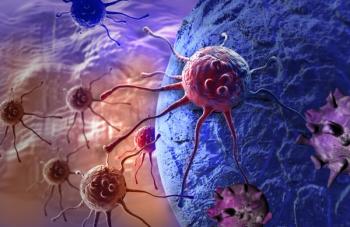
- ONCOLOGY Nurse Edition Vol 24 No 2
- Volume 24
- Issue 2
Helping Patients to Cope With CIPN
Owing to the success of today’s cancer treatments, many cancer survivors are now living through and beyond the cancer experience.
Owing to the success of today’s cancer treatments, many cancer survivors are now living through and beyond the cancer experience. However, an unwanted outcome of this success is that some cancer survivors may be left with protracted treatment complications or late effects such as chemotherapy-induced peripheral neuropathy (CIPN) and associated neuropathic pain. CIPN is a dose-limiting side effect of a variety of commonly used chemotherapy agents, including the platinum drugs, taxanes, epothilones, vinca alkaloids, and newer drugs such as lenalidomide (Revlimid) and bortezomib (Velcade), among others.[1] Given this realization, increasing attention is now being paid to ameliorating CIPN-associated negative effects on cancer survivors’ function and quality of life.
The article by Boland and colleagues makes a positive step in this direction by providing valuable information that will empower nurses to take an active role in CIPN assessment, prevention, and treatment. It highlights the case of a breast cancer patient with type II diabetes, a pre-existing comorbid risk factor for neuropathy, who receives as part of her chemotherapy regimen moderate to high dose, dose-dense, paclitaxel. Acute peripheral neuropathy is known to be a common side effect of paclitaxel, especially with dose-dense schedules of therapy. The authors rightly recommend that prechemotherapy neuropathy assessments be conducted on all patients receiving neurotoxic chemotherapy. Pretreatment assessments are especially important for those with comorbid conditions that increase neuropathy risk, such as diabetes, certain nutritional deficiencies, or alcoholism, because patients with these conditions are more likely to develop severe and protracted CIPN.
Prospective neuropathy assessments should be conducted at baseline and prior to subsequent chemotherapy treatments so that changes in signs and symptoms can be detected over time. The main benefit of prospective monitoring is that alternative chemotherapeutic agents, dosages, and scheduling can be considered before symptoms become severe, thereby minimizing patient suffering and avoiding possible cessation of chemotherapy. As a secondary outcome, nurse monitoring can lead to increased patient awareness regarding CIPN symptoms, and nurses can teach patients about safety and symptom control strategies during the examination.
As a next step, I encourage oncology nurses to gain neurologic assessment skills through mentored teaching, possibly alongside a neurologist or neuro-oncology nurse practitioner. Nurses can request these mentored opportunities merely by asking an expert colleague to demonstrate neuropathy assessment techniques. In addition, more formal learning opportunities are becoming available via Oncology Nursing Society–sponsored conferences, as well as through local continuing education lectures.
Seeking out neuropathy assessment learning experiences will help nurses to incorporate CIPN assessment and treatment strategies into daily clinical practice. In turn, nurses can be in a better position to collaborate with the medical team when chemotherapy options are planned, especially when nurses are aware of CIPN symptoms or functional impairments that are unknown to other medical team members. For example, patients frequently report seemingly minor functional problems to the nurse instead of to the physician. Therefore, the nurse may be the first to hear that a patient has been stumbling, dropping objects, or is unable to perform simple tasks such as typing, sewing, or dressing.
The authors suggest that patients undergo routine nerve conduction in addition to a neuropathy-focused physical examination. Based on the current state of the science, it is unclear whether neurologist referral for more complex testing of this nature is necessary when monitoring established CIPN, because the information gained must be balanced against the discomfort, cost, and inconvenience of these tests. Nurse-conducted, simple, subjective and objective monitoring approaches should be adequate in most cases when CIPN is the established diagnosis.
More specifically, nurses should assess neuropathy severity by asking patients about the level of proximal extension of subjective symptoms such as numbness, tingling, and neuropathic pain. Proximal symptom extension is indicative of worsening neuropathy because symptoms typically begin in the toes and feet and extend up the leg, and then to fingers and hands as neuropathy becomes more severe. In addition to subjective symptom assessment, nurses also can learn to assess important objective CIPN signs via basic neurologic examination techniques such as vibratory sensibility and tendon reflex testing.
The total neuropathy score (TNS), a comprehensive composite tool for assessment of CIPN, could be used to systematically quantify subjective and objective findings. However, while the TNS can be used to convert most CIPN signs and symptoms into a numerical score, it cannot be used to accurately assess the severity of neuropathy-related pain. In addition, due to the inclusion of nerve conduction studies and quantitative sensory testing, it is currently too complex for use by oncology nurses. Further revision, simplification, and testing of the tool are needed to facilitate its use by oncology nurses.[2]
Lastly, the article by Boland et al. provides anecdotal evidence via the case presentation that effective treatment of CIPN-related pain and functional deficits can facilitate overall recovery. I have certainly witnessed similar patient outcomes within my own clinical practice. However, additional research is needed to build upon the current scientific evidence regarding the efficacy of the treatment interventions described in the case study. Broad recommendations of specific agents for prophylaxis or treatment of CIPN are not yet possible.[3] (See, for example, evaluation of research on pharmacologic and nonpharmacologic intervention for CIPN as discussed in the “Putting Evidence Into Practice” [PEP] summary on the Oncology Nursing Society website, available at: www.ons.org/Research/PEP/Topics/Peripheral.) In particular, paclitaxel is associated with a unique acute pain syndrome that is believed to be caused by small nerve fiber injury, and to date there have been no reports of the ability to prevent neuropathic pain resulting from treatment with paclitaxel.[1]
In conclusion, I commend the authors for writing this article. While prevention and treatment of pain and altered sensations associated with CIPN continue to be a challenge, strategies exist that can improve quality of life for some patients. It is hoped that ongoing research on CIPN shared in the medical literature will lead to improved clinical, functional, economic, and satisfaction-related patient outcomes.
Financial Disclosure:The author has no significant financial interest or other relationship with the manufacturer of any products or providers of any service mentioned in this article.
References:
Financial Disclosure: The author has no signifi cant fi nancial interestor other relationship with the manufacturer of any products orproviders of any service mentioned in this article.
References
1. Wolf S, Barton D, Kottschade L, et al: Chemotherapy-induced peripheral neuropathy: Prevention and treatment strategies. Eur J Cancer 44(11):1507â1515, 2008.
2. Smith EM, Beck SL, Cohen J: The total neuropathy score: A tool for measuring chemotherapy-induced peripheral neuropathy. Oncol Nurs Forum 35(1):96â102, 2008.
3: Kaley TJ, Deangelis LM: Therapy of chemotherapy-induced peripheral neuropathy. Br J Haematol 145(1):3â14, 2009.
Articles in this issue
almost 16 years ago
Chemotherapy-Induced Peripheral Neuropathy in Cancer Survivorsalmost 16 years ago
PARP* Inhibitors in BRCA-Associated Cancersalmost 16 years ago
Genetics and Genomics: A New Frontier in Oncologyalmost 16 years ago
Genetics, Genomics, and Cancer: The Future Is Nowalmost 16 years ago
Health Literacy: Strategies for Avoiding Communication Breakdownalmost 16 years ago
Coping With ‘Chemobrain’almost 16 years ago
Integrating Genetics and Genomics Into Oncology NursingNewsletter
Stay up to date on recent advances in the multidisciplinary approach to cancer.

















































































